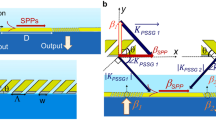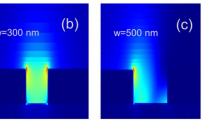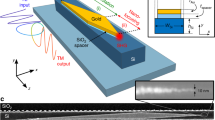Abstract
When a light wave strikes a metal film it can, under appropriate conditions, excite a surface plasmon polariton (SPP)—a surface electromagnetic wave that is coupled to the free electrons in the metal. Such SPPs are involved in a wide range of phenomena1, including nanoscale optical waveguiding2,3,4,5, perfect lensing6, extraordinary optical transmission7, subwavelength lithography8 and ultrahigh-sensitivity biosensing9. However, before the full potential of technology based on SPPs (termed ‘plasmonics’) can be realized, many fundamental questions regarding the interaction between light and matter at the nanoscale need to be answered. For over 200 years, Young's double-slit experiment has been a valuable pedagogical tool for demonstrating the wave nature of light10. Here, we perform a double-slit experiment with SPPs to reveal the strong analogy between SPP propagation along the surface of metallic structures and light propagation in conventional dielectric components (such as glass waveguides). This allows us to construct a general framework to describe the propagation, diffraction and interference of SPPs. It also suggests that there is an effective diffraction limit for the lateral confinement of SPPs on metal stripe waveguides, and justifies the use of well-developed concepts from conventional optics and photonics in the design of new plasmonic devices.
This is a preview of subscription content, access via your institution
Access options
Subscribe to this journal
Receive 12 print issues and online access
$259.00 per year
only $21.58 per issue
Buy this article
- Purchase on Springer Link
- Instant access to full article PDF
Prices may be subject to local taxes which are calculated during checkout



Similar content being viewed by others
References
Barnes, W. L., Dereux, A. & Ebbesen, T. W. Surface plasmon subwavelength optics. Nature 424, 824–830 (2003).
Bozhevolnyi, S. I., Volkov, V. S., Devaux, E., Laluet, J. Y. & Ebbesen, T. W. Channel plasmon subwavelength waveguide components including interferometers and ring resonators. Nature 440, 508–511 (2006).
Takahara, J., Yamagishi, S., Taki, H., Morimoto, A. & Kobayashi, T. Guiding of a one-dimensional optical beam with nanometer diameter. Opt. Lett. 22, 475–477 (1997).
Takahara, J. & Kobayashi, T. Low-dimensional optical waves and nano-optical circuits. Opt. Photonics News 15, 54–59 (2004).
Zia, R., Schuller, J. A., Chandran, A. & Brongersma, M. L. Plasmonics: the next chip-scale technology. Mater. Today 9, 20–27 (July/August 2006).
Pendry, J. B. Negative refraction makes a perfect lens. Phys. Rev. Lett. 85, 3966–3969 (2000).
Ebbesen, T. W., Lezec, H. J., Ghaemi, H. F., Thio, T. & Wolff, P. A. Extraordinary optical transmission through sub-wavelength hole arrays. Nature 391, 667–669 (1998).
Fang, N., Lee, H., Sun, C. & Zhang, X. Sub-diffraction-limited optical imaging with a silver superlens. Science 308, 534–537 (2005).
Liedberg, B., Nylander, C. & Lundstrom, I. Surface plasmon resonance for gas detection and biosensing. Sens. Actuators 4, 299–304 (1983).
Young, T. A Course of Lectures on Natural Philosophy and the Mechanical Arts (J. Johnson, London, 1807).
Krenn, J. R. et al. Non-diffraction-limited light transport by gold nanowires. Europhys. Lett. 60, 663–669 (2002).
Weeber, J. C., Lacroute, Y. & Dereux, A. Optical near-field distributions of surface plasmon waveguide modes. Phys. Rev. B 68, 115401 (2003).
Zia, R., Schuller, J. A. & Brongersma, M. L. Near-field characterization of guided polariton propagation and cutoff in surface plasmon waveguides. Phys. Rev. B 74, 165415 (2006).
Joensson, C. Elektroneninterferenzen an mehreren kunstlich hergestellten feinspalten. Z. Phys. 161, 454–474 (1961).
Keith, D. W., Ekstrom, C. R., Turchette, Q. A. & Pritchard, D. E. An interferometer for atoms. Phys. Rev. Lett. 66, 2693–2696 (1991).
Schouten, H. F. et al. Plasmon-assisted two-slit transmission: Young's experiment revisited. Phys. Rev. Lett. 94, 053901 (2005).
Zia, R., Selker, M. D. & Brongersma, M. L. Leaky and bound modes of surface plasmon waveguides. Phys. Rev. B 71, 165431 (2005).
Burke, J. J., Stegeman, G. I. & Tamir, T. Surface-polariton-like waves guided by thin, lossy metal films. Phys. Rev. B 33, 5186–5201 (1986).
Zia, R., Chandran, A. & Brongersma, M. L. Dielectric waveguide model for guided surface polaritons. Opt. Lett. 30, 1473–1475 (2005).
Anemogiannis, E., Glytsis, E. N. & Gaylord, T. K. Determination of guided and leaky modes in lossless and lossy planar multilayer optical waveguides: reflection pole method and wavevector density method. J. Lightwave Technol. 17, 929–941 (1999).
Boltasseva, A. et al. Integrated optical components utilizing long-range surface plasmon polaritons. J. Lightwave Technol. 23, 413–422 (2005).
Karalis, A., Lidorikis, E., Ibanescu, M., Joannopoulos, J. D. & Soljacic, M. Surface-plasmon-assisted guiding of broadband slow and subwavelength light in air. Phys. Rev. Lett. 95, 063901 (2005).
Goodman, J. Introduction to Fourier Optics (McGraw-Hill, New York, 1988).
Veronis, G. & Fan, S. H. Bends and splitters in metal–dielectric–metal subwavelength plasmonic waveguides. Appl. Phys. Lett. 87, 131102 (2005).
Veronis, G. & Fan, S. H. Guided subwavelength plasmonic mode supported by a slot in a thin metal film. Opt. Lett. 30, 3359–3361 (2005).
Pile, D. F. P. et al. Two-dimensionally localized modes of a nanoscale gap plasmon waveguide. Appl. Phys. Lett. 87, 261114 (2005).
Acknowledgements
This work was supported by a DoD MURI sponsored by the AFOSR (F49550-04-10437) and an NSF Career Award (ECS-0348800). The authors thank Mark D. Selker, Jon A. Schuller and Anu Chandran for helpful discussions.
Author information
Authors and Affiliations
Contributions
R.Z. and M.L.B. conceived the experiments together. R.Z. conducted the experiments and simulations. R.Z. and M.L.B. co-wrote the manuscript.
Corresponding authors
Ethics declarations
Competing interests
The authors declare no competing financial interests.
Supplementary information
Supplementary Information
Supplementary discussion (PDF 80 kb)
Rights and permissions
About this article
Cite this article
Zia, R., Brongersma, M. Surface plasmon polariton analogue to Young's double-slit experiment. Nature Nanotech 2, 426–429 (2007). https://doi.org/10.1038/nnano.2007.185
Received:
Accepted:
Published:
Issue Date:
DOI: https://doi.org/10.1038/nnano.2007.185
This article is cited by
-
High-Sensitivity Sensor Based on Plasmon-Induced Transparency in Terahertz Borophene Metasurface
Plasmonics (2024)
-
Fractional Young double-slit numerical experiment with Gaussian wavepackets
Scientific Reports (2020)
-
Plasmonic bio-sensing for the Fenna-Matthews-Olson complex
Scientific Reports (2017)
-
Nanoscale optical interferometry with incoherent light
Scientific Reports (2016)
-
Probing the spectral density of the surface electromagnetic fields through scattering of waveguide photons
Scientific Reports (2016)



